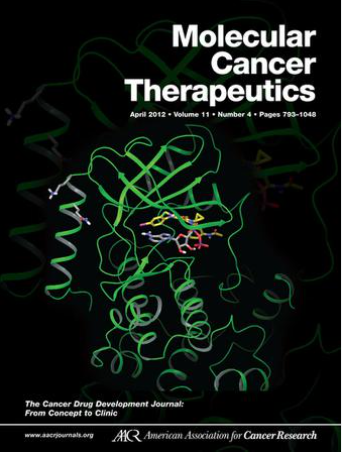摘要 PR007:阐明食管腺癌的功能性驱动因素以识别合成致死相互作用
IF 5.3
2区 医学
Q1 ONCOLOGY
引用次数: 0
摘要
食管腺癌(EAC)分子靶向疗法的应用因缺乏可药用的致癌驱动因素而受到限制。我们提出,合成致死相互作用可为食管腺癌的靶向治疗提供新的机会。我们采用综合多组学方法,结合 Perturb-Seq(CRISPR 编辑与单细胞 RNA 测序相结合)和体内肿瘤发生试验,对超过 70 个高可信度的 EAC 驱动基因进行了高通量表征,并在 EAC 肿瘤发生的同源模型中进行了全基因组 CRISPR-Cas9 基因敲除筛选,以确定与疾病相关的合成致死基因相互作用。利用基于 MS 的蛋白质组学、反相蛋白质阵列、多聚酶谱分析和异源模型的大容量 RNA 测序,对真正的 EAC 驱动基因和相关的特定驱动基因依赖性的生物学特性进行了研究。研究的总体目标是:(i) 加强我们对 EAC 肿瘤发生的了解;(ii) 通过类似合成致死的方法,确定针对 EAC 驱动因子的潜在治疗干预机会;(iii) 通过对具有相似表型结果的 EAC 驱动因子进行分类,降低遗传异质性的复杂性。通过我们的方法,我们发现了肿瘤抑制因子 SMAD4 与 mTOR 信号调控之间的复杂串扰,以及对 EAC 翻译重编程的特定下游影响。在我们的体内肿瘤发生模型中,SMAD4 的突变或缺失发生在高达 20% 的 EAC 中,但不包括恶性前组织(巴雷特食管),而且足以促进恶性前细胞的转化。在该模型中,异种移植的 SMAD4 缺陷(通过 CRISPR-Cas9 敲除或 shRNA 敲除)的巴雷特食管变性细胞在潜伏一段时间后形成侵袭性、转移性肿瘤。SMAD4 缺陷细胞的 4E-BP1 表达下调,4E-BP1 可抑制 EIF4E(依赖于帽子的翻译启动因子)。这伴随着 mTOR 活性的增加,包括 4EBP1 的磷酸化和失活。此外,我们发现 SMAD4 缺失的细胞优先上调帽子依赖性翻译,而牺牲 IRES 介导的翻译。此外,在敲除 SMAD4 的同时干扰 mTOR 信号转导的其他负调控因子会加剧这些效应并加速体内肿瘤的发生。我们将这些发现扩展到了巴雷特食管患者衍生的器官组织(PDOs)模型中,观察到我们的转基因 PDOs 的增殖潜力增加了。最后,分析 Perturb-seq 中差异表达基因的基因本体发现,驱动因素依赖性转录变化可归类为较少数量的功能通路,从而使我们有可能将驱动因素组视为功能单元。这项工作加深了我们对EAC肿瘤发生的理解,为SMAD4驱动的转化提供了新的机理认识,并为SMAD4缺陷型EAC提供了新的潜在治疗途径。引用格式:Julia V. Milne, Ebtihal Mustafa, Kenji Fujihara, Eric Kusnadi, Anna Trigos, Niko Thio, Maree Pechlivanis, Carlos Cabalag, Twishi Gulati, Kaylene Simpson, Cuong Duong, Luc Furic, Wayne Phillips, Nicholas Clemons.描述食管腺癌的功能驱动因素以识别合成致命相互作用 [摘要]。In:AACR 癌症研究特别会议论文集:扩展和转化癌症合成脆弱性;2024 年 6 月 10-13 日;加拿大魁北克省蒙特利尔。费城(宾夕法尼亚州):AACR; Mol Cancer Ther 2024;23(6 Suppl):Abstract nr PR007.本文章由计算机程序翻译,如有差异,请以英文原文为准。
Abstract PR007: Delineating functional drivers of esophageal adenocarcinoma to identify synthetic lethal interactions
Application of molecular targeted therapies for esophageal adenocarcinoma (EAC) has been limited by a lack of druggable oncogenic drivers. We propose that synthetic lethal interactions may provide new opportunities for targeted therapies in EAC. We have taken an integrated multi-omics approach incorporating Perturb-Seq (CRISPR editing combined with single cell RNA sequencing) and in vivo tumorigenesis assays to perform high-throughput characterisation of >70 high-confidence EAC driver genes, and genome-wide CRISPR-Cas9 knockout screens in isogenic models of EAC tumorigenesis to identify disease relevant synthetic lethal genetic interactions. MS-based proteomics, reverse phase protein arrays, polysome profiling and bulk RNA-sequencing of isogenic models were utilised to interrogate the biology of bona fide EAC drivers and associated driver specific gene dependencies. The overall goals were to (i) enhance our understanding of EAC tumorigenesis, (ii) identify potential opportunities for therapeutic interventions targeting EAC drivers via synthetic lethal-like approaches, and (iii) reduce the complexity of genetic heterogeneity by categorising EAC drivers with similar phenotypic outcomes. Through our approach we have identified complex crosstalk between the tumor suppressor SMAD4 and regulation of mTOR signaling, with specific downstream effects on translational reprogramming in EAC. Mutation or loss of SMAD4 occurs in up to 20% of EAC, but not pre-malignant tissue (Barrett’s esophagus), and is sufficient to promote transformation of pre-malignant cells in our in vivo tumorigenesis model. In this model, xenotransplanted SMAD4-deficient (via CRISPR-Cas9 knockout or shRNA knockdown) Barrett’s metaplasia cells formed invasive, metastatic tumors after a period of latency. SMAD4 deficient cells had downregulated expression of 4E-BP1, which inhibits EIF4E, the cap-dependent translation initiation factor. This was accompanied by increased mTOR activity, including phosphorylation and inactivation of 4EBP1. Moreover, we found that SMAD4-deficient cells preferentially upregulate cap-dependent translation at the expense of IRES mediated translation. Furthermore, perturbation of additional negative regulators of mTOR signaling in combination with SMAD4 knockout exacerbated these effects and accelerated tumorigenesis in vivo. We have extended these findings to a model of Barrett’s esophagus patient-derived organoids (PDOs) and observed increased proliferative potential of our genetically modified PDOs. Finally, analysing gene ontologies for differentially expressed genes from Perturb-seq revealed that driver-dependent transcriptional changes can be categorized into a smaller number of functional pathways allowing us to potentially consider groups of drivers as functional units. This work advances our understanding of EAC tumorigenesis, provides new mechanistic insights into SMAD4-driven transformation as well as novel potential therapeutic avenues for SMAD4-deficient EAC.
Citation Format: Julia V. Milne, Ebtihal Mustafa, Kenji Fujihara, Eric Kusnadi, Anna Trigos, Niko Thio, Maree Pechlivanis, Carlos Cabalag, Twishi Gulati, Kaylene Simpson, Cuong Duong, Luc Furic, Wayne Phillips, Nicholas Clemons. Delineating functional drivers of esophageal adenocarcinoma to identify synthetic lethal interactions [abstract]. In: Proceedings of the AACR Special Conference in Cancer Research: Expanding and Translating Cancer Synthetic Vulnerabilities; 2024 Jun 10-13; Montreal, Quebec, Canada. Philadelphia (PA): AACR; Mol Cancer Ther 2024;23(6 Suppl):Abstract nr PR007.
求助全文
通过发布文献求助,成功后即可免费获取论文全文。
去求助
来源期刊
CiteScore
11.20
自引率
1.80%
发文量
331
审稿时长
3 months
期刊介绍:
Molecular Cancer Therapeutics will focus on basic research that has implications for cancer therapeutics in the following areas: Experimental Cancer Therapeutics, Identification of Molecular Targets, Targets for Chemoprevention, New Models, Cancer Chemistry and Drug Discovery, Molecular and Cellular Pharmacology, Molecular Classification of Tumors, and Bioinformatics and Computational Molecular Biology. The journal provides a publication forum for these emerging disciplines that is focused specifically on cancer research. Papers are stringently reviewed and only those that report results of novel, timely, and significant research and meet high standards of scientific merit will be accepted for publication.

 求助内容:
求助内容: 应助结果提醒方式:
应助结果提醒方式:


